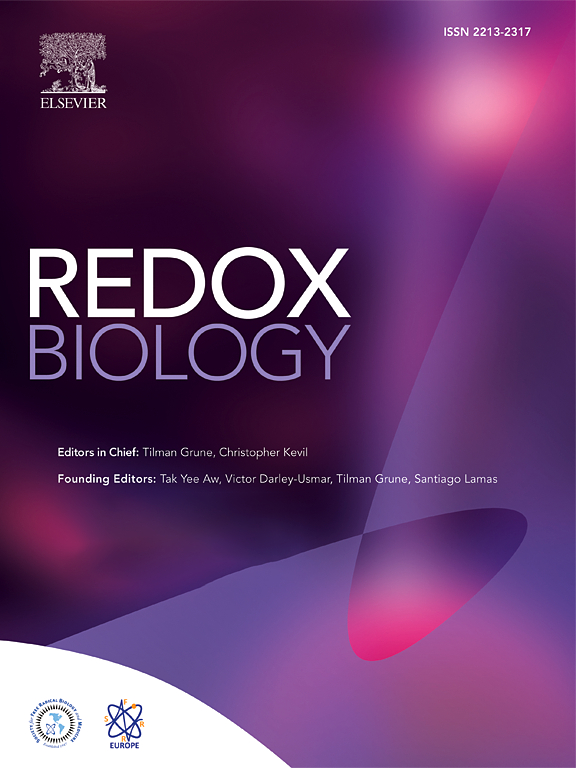Evidence for alcohol-mediated hemolysis and erythrophagocytosis
IF 10.7
1区 生物学
Q1 BIOCHEMISTRY & MOLECULAR BIOLOGY
引用次数: 0
Abstract
Alcohol-related liver disease (ALD) is the most common liver disease worldwide; however, its underlying molecular mechanisms remain poorly understood. Here, we identify ethanol-mediated hemolysis and erythrophagocytosis as major contributors to ALD pathogenesis using both in vitro and in vivo models, as well as surrogate markers such as heme oxygenase-1 (HO-1) and CD163, a scavenger receptor for hemoglobin-haptoglobin complexes.
A key initial observation was the direct optical evidence of serum hemolysis in heavy drinkers, which diminished after one week of alcohol withdrawal. In parallel, soluble CD163 (sCD163) levels declined during alcohol detoxification correlating with liver damage and fibrosis stages. Moreover, red blood cells (RBCs) from heavy drinkers exhibited increased fragility under hemolytic stress. In ethanol-fed mice, we also observed serum hemolysis. Erythrophagocytosis in liver tissue was visualized by co-localization of CD163 and hemoglobin autofluorescence. In vitro studies confirmed that ethanol – at concentrations transiently present in the upper gastrointestinal tract during alcohol ingestion – directly induces hemolysis and primes RBCs for erythrophagocytosis through eryptosis, marked by externalization of phosphatidylserine. Both heme, released during hemolysis, and bilirubin, its degradation product, further amplified erythrophagocytosis at clinically relevant concentrations, suggesting a self-perpetuating cycle. The antioxidant N-acetylcysteine efficiently blocked ethanol-induced RBC priming for erythrophagocytosis.
In conclusion, alcohol triggers a cascade of hemolysis, eryptosis, and erythrophagocytosis that may contribute to the pathogenesis of alcoholic hepatitis and end-stage ALD. sCD163 could serve as a noninvasive marker of hemolysis-associated macrophage activation. This mechanism opens new avenues for antioxidant-based therapies and may help to explain typical iron abnormalities, including ferroptosis, and hyperbilirubinemia in ALD.

酒精介导的溶血和红细胞吞噬的证据
酒精相关性肝病(ALD)是世界上最常见的肝病;然而,其潜在的分子机制仍然知之甚少。在这里,我们通过体外和体内模型,以及血红素加氧酶-1 (HO-1)和CD163(一种血红蛋白-接触珠蛋白复合物的清道夫受体)等替代标志物,确定乙醇介导的溶血和红细胞吞噬是ALD发病的主要因素。一项关键的初步观察是重度饮酒者血清溶血的直接光学证据,在戒酒一周后,血清溶血减少。同时,可溶性CD163 (sCD163)水平在酒精解毒期间下降,与肝损伤和纤维化阶段相关。此外,大量饮酒者的红细胞在溶血压力下表现出更大的脆弱性。在乙醇喂养的小鼠中,我们也观察到血清溶血。通过CD163和血红蛋白自身荧光共定位观察肝组织的红细胞吞噬情况。体外研究证实,酒精摄入过程中短暂存在于上消化道的乙醇浓度可直接诱导溶血,并通过红血球激活红细胞,以磷脂酰丝氨酸外化为标志。溶血过程中释放的血红素及其降解产物胆红素在临床相关浓度下进一步放大了红细胞吞噬作用,表明这是一个自我延续的循环。抗氧化剂n -乙酰半胱氨酸有效阻断乙醇诱导的红细胞启动红细胞吞噬作用。总之,酒精引发了溶血、红细胞增多和红细胞吞噬的级联反应,这可能有助于酒精性肝炎和终末期ALD的发病机制。sCD163可以作为溶血相关巨噬细胞激活的无创标志物。这一机制为基于抗氧化剂的治疗开辟了新的途径,并可能有助于解释ALD中典型的铁异常,包括铁下垂和高胆红素血症。
本文章由计算机程序翻译,如有差异,请以英文原文为准。
求助全文
约1分钟内获得全文
求助全文
来源期刊

Redox Biology
BIOCHEMISTRY & MOLECULAR BIOLOGY-
CiteScore
19.90
自引率
3.50%
发文量
318
审稿时长
25 days
期刊介绍:
Redox Biology is the official journal of the Society for Redox Biology and Medicine and the Society for Free Radical Research-Europe. It is also affiliated with the International Society for Free Radical Research (SFRRI). This journal serves as a platform for publishing pioneering research, innovative methods, and comprehensive review articles in the field of redox biology, encompassing both health and disease.
Redox Biology welcomes various forms of contributions, including research articles (short or full communications), methods, mini-reviews, and commentaries. Through its diverse range of published content, Redox Biology aims to foster advancements and insights in the understanding of redox biology and its implications.
 求助内容:
求助内容: 应助结果提醒方式:
应助结果提醒方式:


